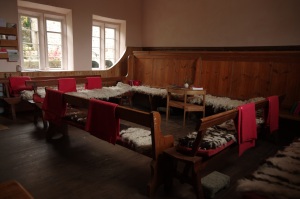
The Meeting House is a historic and atmospheric place. Originally an early seventeenth century stone built thatched barn, it was purchased in 1700 by William and Alice Ellis, a Quaker couple from the village, from John Lambert, son of Cromwell’s Major General John Lambert.
Airton Meeting House was built in the early seventeenth century, probably in about 1610, as a semi-clandestine meeting place for an unknown group of dissenting worshipers who may have identified themselves as Seekers. By the mid 1650s it was in regular use for Quaker meetings for worship. It is both one of the oldest Dissenter places of worship in Britain and one of the earliest Quaker meeting houses. Although constructed to look like a vernacular stone barn, the absence of any door facing onto the street, concealed entrance in what should be the building’s rear face and exterior stone bench indicate that its intended purpose has always been that of an assembly hall.

Successful efforts to obscure the origin and original purpose of the building have left uncertainties about its early history. Most probably it was constructed by Josias Lambert, father of the future Major General Lambert (active in Oliver Cromwell’s circle during the English Civil War). It was purchased from the Lambert family in 1700 by Quakers William and Alice Ellis, who endowed it to Quaker trustees. In about 1694, the Ellises refurbished the interior of the Meeting House, including installing oak wall panelling and a room divider with drop shutters. More extensive improvements were made in 1710 by Alice Ellis.
The Meeting House, external stone bench and archway leading into the Meeting House yard are listed by Historic England as grade 2* in recognition of their historic and architectural significance.
 Early in the new millennium, a small group of Friends carried out a successful and sensitive refurbishment of the fabric of the buildings, which are now used regularly both by the local Quaker Meeting and hired by other groups.
Early in the new millennium, a small group of Friends carried out a successful and sensitive refurbishment of the fabric of the buildings, which are now used regularly both by the local Quaker Meeting and hired by other groups.
For more about Quakers in general, see About Quakers.
The following leaflet is available in the Meeting House to take away: